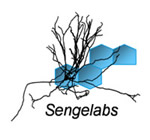Research
Neuroprotective effects of gonadal steroids in models of spinal motoneuron injury
We have demonstrated that the gonadal steroids, testosterone and it’s active metabolites estradiol and dihydritestosterone, have therapeutic effects in the spinal cord, protecting surviving motoneurons from atrophy after injury, and regulating the expression of receptors for trophic factors, proteins critical for the maintenance of normal structure and function. This work has important implications in that if the appropriate trophic support can be provided to injured motoneurons, then the progression of neurodegenerative diseases or lesions could be slowed, and the time required for the recovery of motor function after injury could be reduced. More >>
Central consequences of peripheral nerve repair
In collaboration with colleagues at the University of Texas at Austin, we have been working on a novel nerve repair strategy that produces dramatically better outcomes than what is achieved with standard clinical practice. This axonal repair technique consists of a series of pharmaceutical agents including the membrane fusogen polyethylene glycol (PEG), in conjunction with microsuturing of the proximal and distal nerve segments. My lab is particularly interested in the central consequences of PEG-fusion repair. More >>
Development and plasticity of hormone-sensitive motoneurons
In the rat brain, estradiol is considered to be responsible for the differentiation of sexually dimorphic brain regions. In contrast, the development of sexually dimorphic nuclei in the rat spinal cord has been considered to be regulated by androgens and not estradiol. More >>
